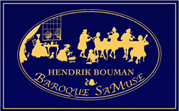*

parts or, for that matter, in the cello part of early piano trios. No, here the gamba moves with an independent voice through all its registers, now low, adding warmth to the already full-sounding bass strings of the harpsichord, then up high, meeting its violin partner for creating an occasional duo. And the switch between those roles is lightning quick, requiring great versatility from the player.
As for the violin (or its optional substitute, the flute), it winds itself around the right hand part of the harpsichord, having its own say, it enters into dialogue or melts into a sweet unison, thereby creating, as it were, a new colour, or again, enriching the consonances and, more particularly, the dissonances with a few smooth or punctuated notes.
Both accompanying instruments, like agile pantomime players, hop steadily from one role into another. They throw out a little gesture here, a languishing cry there, almost disjointed, but the whole makes total sense, and more than that, a beautiful depth is reached like with a monochrome drawing by Watteau that is transformed into a painting, full of subtle shades and delicate detail.
But music being music, and Rameau being Rameau, the composer adds to these ‘sound washes’ that magical touch of life that is rhythm. And magic it is, because Rameau does not keep necessarily to the substance with which he has introduced a piece like a conventional baroque composer. Rameau moves on; he is the perfect story-teller, he interrupts himself, throws in a cascade, wipes a tear, or makes the music scintillate like a lark in the sky. Rameau is totally theatrical and knows how to set the salon on fire. And yet, he remains respectful towards his audience, society, and therefore maintains the required dignified restraint, though punctuated with strokes of subtle wit, thus masterfully hiding his art with art itself, to paraphrase the Master.
©Hendrik BOUMAN, Toulouse 2021

I picture him sitting there lankily on that easy Louis XV chair, a draft on his lap. The lines of his profile sharpened by age, his head slightly tilted as if pondering on a theme; a keen eye, reflecting intelligence, imagination, perseverance, and... solitude.
I just listened to Rameau’s 5 ‘Concerts’ [Pièces de Clavecin en concert]. It is both felicitous and regrettable that they occupy such a unique place in the repertoire. One would have wished that there were more of them and that those delightful compositions had served as an inspiring model to other composers. But the spirit of the time was turning a page on most of what Rameau stood for, and he was soon to become respected rather as a monument than for the incredible innovator he was.
What an amazing originality! First off all, the concept, five sets of harpsichord pieces to be played with optional accompaniment, and not the customary reversal, in which the harpsichord was assigned to play the accompanying role. And then the genius with which this tone painter manipulates his medium. Of course, due to its very nature, the harpsichord, even in it obbligato role, gets regularly covered by the two other instruments, violin and viola da gamba. But this is no compositional weakness, it is planned, willed with highly artistic calculation. Like a proud ship, each time the harpsichord solo part seems to become submerged, it pops up again with its prow piercing out of the enveloping sound waves, to take over the lead.
Rameau treats the harpsichord like no other. One reads from the score that special chemistry between creative push and enjoyment. Here is a natural player at work, someone who knows by experience what works on the instrument, what creates interest.
And let us see what the accompanying instruments are made to do, especially the gamba. She is not given a play-along bass line like one finds in continuo

HENDRIK BOUMAN
Rameau, rameau...! Musings on a portrait of Jean-Philippe Rameau, 1760, Louis Carrogis Carmontelle (2020)



